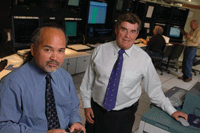The chaos that began on Sept. 11, 2001, and continued for weeks afterward gave municipal officials across the country a new appreciation of the importance of information technology'and communications, in particular. Whether their locales were a target of the attacks or not, the lessons of that day have influenced everyone's approach.Along with interoperability of communications systems, federal, state and local entities have given high priority to continuity of operations for everything from human resources and payroll to property records, and information sharing.But even with the momentum from 9/11 and IT's recognized importance to continuity of government, systems are far from complete.'It's expensive, politically sensitive and involves all sorts of turf issues among agencies'who owns the system and makes the decisions, who has to change their behavior to conform with a new system, and whose budget is being tapped. These are busy people, and this is overload,' said Anthony Cresswell, deputy director of the Center for Technology in Government at the University of Albany, N.Y.Still, 'the best stories we tend to see are at the local level, where people have done a good job at getting smarter, getting information and sharing what they know,' he added.State and local communities across the country have benefited from the billions of dollars flowing in from the federal government for homeland security missions. Just this past summer, DHS said it would give state and local governments about $1.7 billion for homeland security efforts.For this story, we picked three areas that represent how city and county governments have changed since 9/11. New York City and Arlington, Va.'where the Pentagon is located'were obvious choices. We also included St. Louis, where the threat may be just as real, but the focus is not always as sharp.For 2006, St. Louis is supposed to receive $9.2 million in homeland security funding, ranking it in the middle of major urban areas.DHS granted New York City more than $124 million. Arlington County does not get funds directly from DHS; officials there depend on receiving homeland security funding through the state program.While each organization has had to address its own unique challenges, there are, not surprisingly, common issues that came out of 9/11.Even before 9/11, Arlington's technology group, which is operating on a $12.8 million budget this year, had planned to revamp its entire fiber-optic network structure, or Institutional Network, which provides voice, data and video services for all county departments. Arlington's I-Net had gone through the initial design, but after 9/11 that design was thrown out, said chief technology officer Christopher David.'We had to think about levels of redundancy and points of failure,' David said.The new I-Net has been in operation for several years now. It is a single high-speed, secure network connecting government, educational and public facilities that lets agencies share resources and serves as the backbone for e-government activities. The I-Net also is linked to institutional networks of neighboring jurisdictions'Falls Church and Alexandria'to facilitate regional information sharing.[IMGCAP(2)]Arlington's new IT environment also had to enable business continuity. The county has two data centers and decided to go with on-demand computing for departments including payroll and accounts payable, budgeting and purchasing. The applications are run out of Austin, Texas, and have run flawlessly for the last four months, David said.'What that gives you is a built-in business continuity strategy. When you're running applications remotely, if something happens here, we still have complete access. That was a big deal,' he said.Arlington also launched new emergency management technologies and programs after 9/11. The new crash cart for incidents creates an emergency team with computers, notebook PCs and phone communications, and can be hooked up within 90 minutes.David, who works with Arlington CIO Jack Belcher, also noted that Arlington leaders took an innovative approach to the problem of technology interoperability between police and fire emergency vehicles. The team found an old police RV, gutted it, gave it a paint job and outfitted it with technology that includes Internet access, real-time videoconferencing and mobile cameras. It took a year and a half and $110,000 to turn it into a mobile technology support unit, far less money than a new vehicle would have cost.Finally, Arlington made a priority of information sharing across jurisdictional lines, even beyond the I-Net. Using the national Web Emergency Operations Center program, Arlington officials collaborated with regional partners to learn how to manage the emergency management software for any type of incident'from a vehicle wreck to an impending hurricane.'We're pretty well prepared, more prepared than most jurisdictions because we've had to deal with it,' said David. 'There was nothing like the Pentagon disaster to focus people. The challenge is to stay focused without becoming Chicken Little.'Henry Jackson was deputy director for administration at New York City's Office of Emergency Management at the time of the 9/11 attacks. He remembers the loss of the city's Emergency Operations Center, located at 7 World Trade Center, and the transfer of operations, first to the Police Academy for a day and then to Pier 92.In 36 hours, OEM put together a center with 450 workstations to assist 300 people a shift that remained in place until that Thanksgiving, when operations moved downtown to 11 Water St.Now deputy commissioner for technology at OEM, a job he's held since 2002, Jackson and his colleagues are about to move to new headquarters in Brooklyn, just the other side of the Brooklyn Bridge. One of the lessons learned from 9/11 was to be close, but not too close.Another lesson was to build backup. 'We lost our command center [at 7 World Trade Center] and had no backup at the time,' he recalled. 'One of the first things we did was build a backup. It used to be a luxury. Now, it's a necessity.'According to Jackson, the agency's $2 million annual budget really doesn't reflect all that happens within OEM because so much work is done cross-agency, and many of the big-ticket, citywide technology initiatives are funded through the city's Department of IT and Telecommunications.'It's been a little easier to sell our case post-9/11 in terms of creating redundancy and diversity,' said Jackson.In planning for the new headquarters, a lot of thought went into creating a survivable system. 'We're using server farms of blade servers and blade PCs, so all our PCs are back-racked,' he said. 'We've invested in multiple means of wireless transmission. We're trying to take advantage of more mature technologies like wireless, but also trying to build redundancy. We have an awful lot of systems coming under our 24-hour watch command. It's a point of warning for the City of New York.'Jackson said that OEM does 'all the standard stuff''keep data tapes out of the regions, using some off-site systems. But they're still managing back-up disaster recovery traditionally. 'We can't take it all outside because of security concerns,' he said.Jackson and his team also put a number of emergency procurement procedures into place, including disaster recovery contracts with vendors for IT equipment. They've developed notification protocols and relationships with the utilities to encourage communication about problems.A number of communications issues also have been addressed. OEM has purchased Raytheon Corp.'s TRP-1000 Transportable Radio Interconnect, a system that provides radio interoperability on mobile command vehicles. The transportable cases have been mounted on 24 mobile command vehicles.And, in 2003, OEM debuted its Mobile Data Center, a custom-built bus that houses geographical information systems and data collection operations, and can take mapping capabilities to the field for emergencies or large events.'We have a robust GIS department with the city's data and layers of information underneath,' said Jackson. 'We also get together with folks from New Jersey, Connecticut and upstate to share regional data. GIS is a big piece of these operations.'Four months after Michael Wise started his new job as director of St. Louis' IT Services Agency in 2003, he focused on building a more secure and stable network'something he called 'industrial strength''and shifting more critical applications and databases to the Web.Serving 109 different agencies for a city with a population of 350,000, ITSA owns and maintains St. Louis' WAN; develops most of its technology-related policies; and provides network and desktop support, information systems support, systems development and Web development.'The need for business continuity and disaster recovery is making more critical applications more Web-based,' he said. 'In our network, we've built secure, 100-bit Ethernet data pipes between the County-Regional Justice Information System, the City of St. Louis, the St. Louis Police Department and other justice-related agencies. We've also developed an extensive list of Web-based activities for different agencies.'When it comes to emergency management, the agency works with the St. Louis Area Regional Response System, a regional organization serving Missouri and Illinois that was developed to organize and coordinate first responders for a regional event such as an earthquake or tornado.'Since 9/11, there's been much more emphasis on regional, cross-agency initiatives,' Wise said. 'We gain much more with coordination.'While the police department has its own independent technology group, it ties into the city's WAN, so there is a connection between the city and the police. And ITSA helps the city's fire department as well as the Department of Public Safety with their technology missions.'When I first got here, they were working fairly independently,' said Wise. 'But they started moving toward common tools three years ago.'
COOP: CTO Christopher David (left) and CIO Jack Belcher find that Arlington's new Institutional Network, with applications running in Texas, gives them a 'built-in business continuity strategy.'
Stephen Barrett
'The need for business continuity and disaster recovery is making more critical applications more Web-based.' Michael Wise, St. Louis IT Services
Courtesy of St. Louis ITSA








